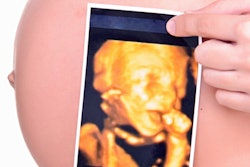
In a disturbing new finding, first-trimester ultrasound was linked to greater severity of autism symptoms, including poorer cognitive outcomes and increased repetitive behaviors, in fetuses with a genetic predisposition to autism spectrum disorder (ASD), according to research published online September 1 in Autism Research.
In a retrospective analysis of data from a national autism genetic repository, a team led by Sara Jane Webb, PhD, of the Seattle Children's Research Institute found that first-trimester ultrasound was associated with lower mean nonverbal IQ and increased repetitive behaviors in boys with ASD and gene copy number variations (CNVs), compared with those who hadn't undergone a first-trimester ultrasound study.
In addition, having a first-trimester ultrasound correlated with increased repetitive behaviors for all children with ASD in the study, regardless of gender or the presence of identified CNVs.
"These data suggest that heterogeneity in ASD symptoms may result, at least in part, from exposure to diagnostic ultrasound during early prenatal development of children with specific genetic vulnerabilities," the authors wrote.
The research team, which also included members from the University of Washington, did not assess if first-trimester ultrasound caused autism -- only whether it affected the severity of ASD symptoms.
A 'triple hit' hypothesis
In 2007, Dr. Manuel Casanova of the University of Louisville proposed a "triple hit" hypothesis for ASD, which attributes the heterogeneity of ASD symptoms to the brain of a genetically at-risk individual being exposed to an exogenous stressor during a time of critical neurodevelopment. It has been suggested that diagnostic ultrasound could act as such a stressor, according to the group (Autism Res, September 1, 2016).
In a number of animal studies, ultrasound in utero has been shown to produce changes in brain structure, as well as alter subsequent behavior after birth. For example, mice exposed to prenatal ultrasound had decreased locomotor and exploratory activities and lower learning ability than mice who hadn't received prenatal ultrasound, the authors wrote.
Meanwhile, the use of obstetric ultrasound has grown substantially over the past five years. Although prenatal diagnostic ultrasound is generally considered to be safe, the U.S. Food and Drug Administration (FDA) and other researchers have continued to emphasize its conservative use for medical purposes, according to the authors.
At the same time, the intensity of ultrasound studies has significantly increased.
"The early FDA restriction on intensity alone was replaced during the 1990s with a nearly eightfold increase in intensity along with imposition of maximum values of a thermal index (TI) to measure the tendency of ultrasound to warm tissue and a mechanical index (MI) related to the likelihood of ultrasound to produce cavitation," they wrote. "This is particularly concerning as ultrasound technicians and maternal fetal medicine fellows demonstrated poor knowledge regarding safety levels [in several research studies]."
The developing central nervous system -- especially during the first trimester -- may be particularly susceptible to hyperthermic injury, according to the group.
However, no randomized studies to date have found a significant or consistent relationship between exposure to ultrasound and congenital anomalies, birth size, cancer/tumors, heart disease, general neonatal and child outcomes, and specific psychopathology such as schizophrenia and psychosis, the authors wrote. In addition, no study has found a direct relationship between ultrasound and autism spectrum disorders.
The vulnerable 1st trimester
The researchers noted, though, that prior research assessing the effect of ultrasound on ASD focused primarily on second-trimester ultrasound.
"Critical to the triple hit hypothesis and not addressed by previous reports, ultrasound as an exogenous stressor would have the most significant impact during the first trimester and only in those with specific genetic risk factors," they wrote. "Given the increase in ultrasound intensity and use, extant animal studies, and lack of human data addressing ASD characteristics and ultrasound exposure during the first trimester of pregnancy, we sought here to explore a variant of Casanova's triple hit hypothesis, assessing factors that may influence the severity of ASD symptoms rather than ASD incidence."
In particular, the group sought to investigate how first-trimester ultrasound related to the severity of ASD symptoms in a group of patients with gene copy number variations that represent a genetic predisposition to ASD. Using data from the Simons Simplex Collection autism genetic repository, the researchers retrospectively analyzed the cases of 1,749 children for whom there was information on whether they had CNVs and whether they had received a first-trimester ultrasound.
They noted that the rates of ultrasound use did not differ between individuals with specific CNV types, such as duplications versus deletions. After performing linear regression analysis on all 1,749 cases, the researchers found that exposure to first-trimester ultrasound was related to lower observed social affective symptoms, but also greater levels of parent-reported restrictive and repetitive behaviors.
| Significant variables for all children with ASD | |||
| No 1st-trimester ultrasound | 1st-trimester ultrasound | p-value | |
| Mean Autism Diagnostic Observation Schedule (ADOS) social affective score | 11.3 | 11.0 | 0.03 |
| Mean Autism Diagnostic Interview - Revised (ADI-R) restrictive and repetitive behaviors score | 6.4 | 6.6 | 0.008 |
Effect on boys
Looking solely at the 111 boys with identified CNVs, first-trimester ultrasound was found to have a statistically significant effect on nonverbal IQ as well as on observed repetitive behaviors.
| Significant variables for boys with CNVs | |||
| No 1st-trimester ultrasound | 1st-trimester ultrasound | p-value | |
| Nonverbal IQ | 92.6 | 78.6 | 0.02 |
| ADOS repetitive domain score | 3.4 | 4.2 | 0.02 |
As there were only 22 girls with ASD and identified CNVs, the researchers weren't able to apply their multiple linear regression model on such a small sample.
The team acknowledged a number of limitations to their study, including its reliance on parent reports for ultrasound exposure and its use of propensity scores to adjust for confounding factors.
"It is possible that despite our use of a propensity score to correct for likelihood of first-trimester ultrasound, there remain residual confounding factors," they wrote. "Disentangling the effect of ultrasound per se versus ultrasound as a proxy for other variables related to outcomes will be critical in future studies."
Nonetheless, the researchers concluded that the combination of first-trimester ultrasound and the presence of CNVs in boys with autism spectrum disorder correlated with poorer cognitive outcomes and increased repetitive behavior.
"Moreover, across gender and independent of the presence of identified CNVs, first-trimester ultrasound correlated with increased repetitive behaviors," the authors wrote.
To fully understand what contributes to heterogeneity in ASD functioning, better knowledge is needed of the range and types of environmental stressors that may interact with genetic vulnerabilities, according to the group.
"If we can better identify the neural development periods most vulnerable to environmental insults, particularly in regard to exposures that can be limited, modified, or regulated by changing practice such as nonmedical use of diagnostic ultrasound imaging, it may be possible to quickly reduce the severity of ASD in future children," they wrote. "Further replication both in larger epidemiological populations and in animal models that can address mechanisms are needed."
In a statement from the University of Washington, senior author Pierre Mourad said the researchers now plan to look more closely into links between ultrasound and autism severity. They will also explore the possibility that ultrasound exposure could contribute to the incidence of autism.




















